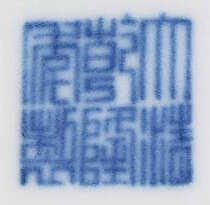A fine and very rare blue and white archaistic stembowl and cover, dou, Qianlong six-character sealmark and of the period
Lot 1320. A fine and very rare blue and white archaistic stembowl and cover, dou, Qianlong six-character sealmark and of the period (1736-1795); 6 7/8 in. (17.5 cm.) overall height. Estimate HKD 900,000 - HKD 1,200,000. Price Realized HKD 3,256,000. © Christie's Images Ltd 2006.
Modelled after an archaic Warring States bronze vessel, dou, with a rounded body supported on a stem and tiered foot, applied with a pair of loop handles at the stepped shoulder, painted in a rich cobalt-blue tone with bands of key-fret around the mid-section and waisted neck of the vessel, above cloud-collar lappets containing dissolved taotie, the stem with eight petals and scrolls around the edge, the domed cover with further key-fret and a stylised four-petal flowerhead radiating from the bud-shaped finial, box.
Exhibited: Kau Chi Society of Hong Kong, Ancient Chinese Ceramics, 1981, Catalogue no. 121
Christie's London, An Exhibition of Important Chinese Ceramics from the Robert Chang Collection, 2-14 June 1993, Catalogue no. 88.
Note: The dou, which consists of a bowl on a tall foot with a domed lid, dates from the fifth century B. C., such as the example from the Freer Gallery of Art, illustrated by William Watson, Ancient Chinese Bronzes, London, 1977, pl. 65a. The closest exact prototype for this porcelain version is a bronze dou inlaid with silver in the Victoria and Albert Museum, London, illustrated by Rose Kerr, Ancient Chinese Bronzes, London, 1990, pl. 58. The scrollwork on the porcelain closely matches that on the bronze. However, further examination and tests on the bronze dou have shown that the bottom half and the lid handle were of different composition to the lid, with the conclusion that the lid is of fifth century B. C. original and that the other parts were added to it later, with the base testing to be fourteenth century or earlier.
This shape is very rarely found on porcelain. An earlier blue and white Xuande-marked dou is in the Palace Museum, Beijing, illustrated in Blue and White Porcelain with Underglazed Red (I), The Complete Collection of Treasures of the Palace Museum, Hong Kong, 2000, pl. 131
Christie's. Imperial Chinese Ceramics from the Robert Chang Collection - Jade Shears and Shimmering Feathers, Hong Kong, 28 November 2006

/https%3A%2F%2Fprofilepics.canalblog.com%2Fprofilepics%2F1%2F0%2F100183.jpg)
/https%3A%2F%2Fstorage.canalblog.com%2F03%2F02%2F119589%2F96711876_o.jpg)
/https%3A%2F%2Fstorage.canalblog.com%2F11%2F31%2F119589%2F94773502_o.jpg)
/https%3A%2F%2Fstorage.canalblog.com%2F20%2F83%2F119589%2F94772815_o.jpg)
/https%3A%2F%2Fstorage.canalblog.com%2F26%2F72%2F119589%2F75604929_o.jpg)
/https%3A%2F%2Fstorage.canalblog.com%2F59%2F60%2F119589%2F26458628_o.jpg)




/image%2F1371349%2F20240416%2Fob_2a8420_437713933-1652609748842371-16764302136.jpg)
/image%2F1371349%2F20240414%2Fob_83ee65_2024-nyr-22642-0954-000-a-blue-and-whi.jpg)
/image%2F1371349%2F20240414%2Fob_15808c_2024-nyr-22642-0953-000-a-blue-and-whi.jpg)
/image%2F1371349%2F20240414%2Fob_e54295_2024-nyr-22642-0952-000-a-rare-blue-an.jpg)